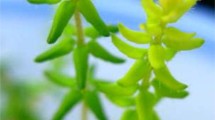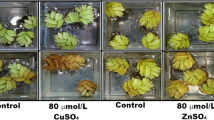Abstract
The tolerance to high Zn was studied in the metallophyte Erica andevalensis Cabezudo & Rivera grown in nutrient solutions at different Zn concentrations (5, 500, 1,000, 1,500 and 2,000 μM Zn). Plant growth and nutrient uptake were determined. Metabolic changes were assessed by the analysis of peroxidase activity, organic metabolites related to metal chelation (amino acids, organic acids (malate, citrate) or protection (polyamines). While plants tolerated up to 1,500 μM Zn, despite presenting of low growth rates, the concentration of 2,000 μM Zn was toxic producing high mortality rates. Roots accumulated high Zn concentration (11,971 mg/kg) at 1,500 μM external Zn) apparently avoiding metal transfer into shoots. After 30 days of treatment with high Zn (1,000 and 1,500 μM Zn), the leaves accumulated high levels of glutamine. Short-term treatment with 500 μM Zn, significantly increased the concentration of asparagine and glutamine in roots. Citrate concentration was also considerably increased when exposing roots to Zn excess. Metal immobilization in the root system, low interference with the uptake of nutrients and an increased production of putative organic ligands (amino acids, citrate) might have provided the Zn tolerance displayed by Erica andevalensis.







Similar content being viewed by others
References
Barceló J, Poschenrieder Ch (1990) Plant water relations as affected by heavy metal stress: a review. J Plant Nutr 13:1–37
Bradford MM (1976) A rapid and sensitive method for quantitation of microgram quantities of protein utilizing the principle of protein-dye-binding. Anal Biochem 72:248–254
Bradley R, Burt AJ, Read DJ (1982) The biology of mycorrhiza in the Ericaceae. VIII. The role of mycorrhizal infection in heavy metal resistance. New Phytol 91:197–209
Broadley MR, White PJ, Hammond JP, Zelko I, Lux A (2007) Zinc in plants. New Phytol 173:677–702
Callahan DL, Baker AJM, Kolev SD, Wedd AG (2006) Metal ion ligands in hyperaccumulating plants. J Biol Inorg Chem 11:2–12
Callahan DL, Kolev SD, O’Hair RAJ, Salt DE, Baker AJM (2007) Relationships of nicotianamine and other amino acids with nickel, zinc and iron in Thlaspi hyperaccumulators. New Phytol 176:836–848
Ernst WHO, Verkleij JAC, Schat H (1992) Metal tolerance in plants. Acta Bot Neerl 41:229–248
Hassinen VH, Tuomainen M, Peräniemi S, Schat H, Kärenlampi SO, Tervahauta AI (2009) Metallothioneins 2 and 3 contribute to the metal-adapted phenotype but are not directly linked to Zn accumulation in the metal hyperaccumulator, Thlaspi caerulescens. J Exp Bot 60:187–196
Haydon MJ, Cobbett CS (2007) Transporters of ligands for essential metal ions in plants. New Phytol 174:499–506
Heinrikson RL, Meredith SC (1984) Amino acid analysis by reverse-phase high-performance liquid chromatography: precolumn derivatization with phenyliso-thiocyanate. Anal Biochem 136:65–74
Hewitt EJ (1966) Sand and water culture methods used in the study of plant nutrition. Technical Communication No. 22 (2nd revised edition). Commonwealth Bureau of Horticulture and Plantation Crops, East Malling, CAB, Farnham Royal, England
Jiménez A, Hernández JA, del Rio LA, Sevilla F (1997) Evidence for the presence of the ascorbate-glutathione cycle in mitochondria and peroxisomes of pea leaves. Plant Physiol 114:275–284
Kochian LV, Pence NS, Letham DLD, Pineros MA, Magalhaes JV, Hoekenga OA, Garvin DF (2002) Mechanisms of metal resistance in plants: aluminum and heavy metals. Plant Soil 247:109–119
Kopittke PM, Menzies NW, de Jonge MD, McKenna BA, Donner E, Webb RI, Paterson DJ, Howard DL, Ryan CG, Glover CJ, Scheckel KG, Lombi E (2011) In situ distribution and speciation of toxic copper, nickel and zinc in hydrated roots of cowpea. Plant Physiol 156:663–673
Lichtenthaler HK (1987) Chlorophylls and carotenoids: Pigments of photosynthetic membranes. Methods in enzymology. Academic Press, New York
Lingua G, Franchin C, Todeschini V, Castiglione S, Biondi S, Burlando B, Parravicini V, Torrigiani P, Berta G (2008) Arbuscular mycorrhizal fungi differentially affect the response to high Zn concentrations of two registered poplar clones. Environ Pollut 153:137–147
Liu F, Tang Y, Du R, Yang H, Wu Q, Qiu R (2010) Root foraging for zinc and cadmium requirement in the Zn/Cd hyperaccumulator plant Sedum alfredii. Plant Soil 327:365–375
Lopez-Archilla AI, Marin I, Amils R (2001) Microbial community composition and ecology of an acidic aquatic environment: the Tinto River, Spain. Microb Ecol 41:20–35
Macnair, MR, Baker AJM (1994) Metal tolerance in plants: evolutionary aspects. In: Farago ME (ed) Plants and the chemical elements.VCH, Weinheim, pp 68–86
Marcé M, Brown DS, Capell T, Figueras X, Tiburcio AF (1995) Rapid high-performance liquid chromatographic method for the quantitation of polyamines as their dansyl derivatives: application to plant and animal tissues. J Chromat B 666:329–335
Márquez-García B, Córdoba F (2010) Antioxidative system in wild populations of Erica andevalensis. Environ Exp Bot 68:58–65
Marschner H (1995) Mineral nutrition of higher plants. Academic Press, London
Meharg AA (2005) Mechanisms of plant resistance to metal and metalloid ions and potential biotechnological applications. Plant Soil 274:163–174
Mingorance MD, Pérez-Vázquez L, Lachica M (1993) Microwave digestion method for the atomic determination of some elements in biological samples. J Anal Atom Spectrom 8:853–858
Mingorance MD, Leidi EO, Valdés B, Rossini Oliva S (2011) Evaluation of lead toxicity in Erica andevalensis as an alternative species for revegetation of contaminated soils. Int J Phytorem 14:174–185
Monaci F, Leidi EO, Mingorance MD, Valdés B, Rossini Oliva S, Bargagli R (2011) The selective uptake of major and trace elements in Erica andevalensis, an endemic species to extreme habitats in the Iberian Pyrite Belt. J Environ Sci 23:444–452
Monsant AC, Kappen P, Wang Y, Pigram PJ, Baker AJM, Tang C (2011) In vivo speciation of zinc in Noccaea caerulescens in response to nitrogen form and zinc exposure. Plant Soil 348:167–183
Påhlsson AMB (1989) Toxicity of heavy metals (Zn, Cu, Cd, Pb) to vascular plants. Water Air Soil Pollut 47:287–319
Rauser WE (1999) Structure and function of metal chelators produced by plants. Cell Biochem Biophys 31:19–48
Reichman SM (2002) The responses of plants to metal toxicity: a review focusing on copper, manganese and zinc. Australian Minerals & Energy Environment Foundation, Melbourne
Rodríguez N, Amils R, Jiménez-Ballesta R, Rufo L, de la Fuente V (2007) Heavy metal content in Erica andevalensis: an endemic plant from the extreme acidic environment of Tinto River and its soils. Arid Land Res Manag 21:51–65
Rossini Oliva S, Bargagli R, Monaci F, Valdés B, Mingorance MD, Leidi EO (2009a) Stress responses of Erica andevalensis Cabezudo & Rivera plants induced by polluted water from Tinto River (SW Spain). Ecotoxicol 18:1058–1067
Rossini Oliva S, Valdés B, Leidi EO (2009b) Accumulation and in vivo tissue distribution of pollutant elements in Erica andevalensis. Sci Total Environ 407:1929–1936
Rossini Oliva S, Mingorance MD, Valdés B, Leidi EO (2010) Uptake, localisation and physiological changes in response to copper excess in Erica andevalensis. Plant Soil 328:211–420
Salt DE, Prince RC, Pickering IJ (2002) Chemical speciation of accumulated metals in plants: evidence from X-ray absorption spectroscopy. Microchem J 71:255–259
Sarret G, Saumitou-Laprade P, Bert V, Proux O, Hazemann JL, Traverse A, Marcus MA, Manceau A (2002) Forms of zinc accumulated in the hyperaccumulator Arabidopsis halleri. Plant Physiol 130:1815–1826
Sharma SS, Dietz KJ (2006) The significance of amino acids and amino acid-derived molecules in plant responses and adaptation to heavy metal stress. J Exp Bot 57:711–726
Shen ZG, Zhao FJ, McGrath SP (1997) Uptake and transport of zinc in the hyperaccumulator Thlaspi caerulescens and the non-hyperaccumulator Thlaspi ochroleucum. Plant, Cell Environ 20:898–906
Shen Z, Zhang F, Zhang F (1998) Toxicity of copper and zinc in seedlings of mung bean and inducing accumulation of polyamine. J Plant Nutr 21:1153–1162
Skopelitis DS, Paranychianakis NV, Paschalidis KA, Pliakonis ED, Delis ID, Yakoumakis DI, Kouvarakis A, Papadakis AK, Stephanou EG, Roubelakis-Angelakis KA (2006) Abiotic stress generates ROS that signal expression of anionic glutamate dehydrogenases to form glutamate for proline synthesis in tobacco and grapevine. Plant Cell 18:2767–2781
Smirnoff N, Stewart GR (1987) Nitrogen assimilation and zinc toxicity to zinc-tolerant and non-tolerant clones of Deschampsia cespitosa (L.) Beauv. New Phytol 107:671–680
Soldevilla M, Marañón T, Cabrera F (1992) Heavy metal content in soil and plants from a pyrite mining area in Southwest Spain. Commun Soil Sci Plant Anal 23:1301–1319
Song A, Li P, Li Z, Fan F, Nikolic M, Liang Y (2011) The alleviation of zinc toxicity by silicon is related to zinc transport and antioxidative reactions in rice. Plant Soil 344:319–333
Tennstedt P, Peisker D, Böttcher C, Trampczynska A, Clemens S (2009) Phytochelatin synthesis is essential for the detoxification of excess zinc and contributes significantly to the accumulation of zinc. Plant Physiol 149:938–948
Turnau K, Henriques FS, Anielska T, Renker C, Buscot F (2007) Metal uptake and detoxification mechanisms in Erica andevalensis growing in a pyrite mine tailing. Environ Exp Bot 61:117–123
Van Assche F, Clijsters H (1990) Effects of metals on enzyme activity in plants. Plant, Cell Environ 13:195–206
Wang J, Evangelou BP, Nielsen MT, Wagner GJ (1992) Computer, simulated evaluation of possible mechanisms for sequestering metal ion activity in plant vacuoles. Plant Physiol 99:621–626
White MC, Decker AM, Chaney RL (1981) Metal complexation in xylem fluid. I. Chemical composition of tomato and soybean stem exudate. Plant Physiol 67:292–300
Wójcik M, Skórzyńska-Polit E, Tukiendorf A (2006) Organic acids accumulation and antioxidant enzyme activities in Thlaspi caerulescens under Zn and Cd stress. Plant Growth Regul 48:145–155
Woolhouse HW (1983) Toxicity and tolerance in the responses of plants to metals. In: Lange OL, Nobel PS, Osmond CB, Ziegler H (eds) Physiological plant ecology III. Springer, Berlin, pp 245–300
Yang XE, Li TQ, Yang JC, He ZL, Lu LL, Meng FH (2006) Zinc compartmentation in root, transport into xylem, and absorption into leaf cells in the hyperaccumulating species of Sedum alfredii Hance. Planta 224:185–195
Yang Z, Wu Y, Li Y, Ling HQ, Chu C (2009) OsMT1a, a type 1 metallothionein, plays the pivotal role in zinc homeostasis and drought tolerance in rice. Plant Mol Biol 70:219–229
Acknowledgments
This research was supported by Spanish Ministry of Science and Education (MEC) (CGL2006-1,418 and José Castillejo Program) and Ramón Areces Foundation. The authors thank technicians at the Greenhouse of University of Seville for their assistance in plant cultivation.
Author information
Authors and Affiliations
Corresponding author
Rights and permissions
About this article
Cite this article
Rossini Oliva, S., Mingorance, M.D. & Leidi, E.O. Tolerance to high Zn in the metallophyte Erica andevalensis Cabezudo & Rivera. Ecotoxicology 21, 2012–2021 (2012). https://doi.org/10.1007/s10646-012-0953-9
Accepted:
Published:
Issue Date:
DOI: https://doi.org/10.1007/s10646-012-0953-9




